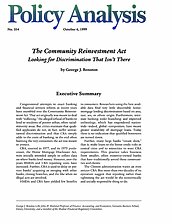Congressional attempts to enact banking and financial services reform in recent years have stumbled over the Community Reinvestment Act. That act originally was meant to deal with “redlining,” the alleged refusal of banks to lend to residents of poorer urban, often racial-minority areas. But critics maintain that qualified applicants do not, in fact, suffer unwarranted discrimination and that CRA simply adds to the costs of banking, in the end often harming the very consumers the act was meant to protect.
CRA, enacted in 1977, and its 1975 predecessor, the Home Mortgage Disclosure Act, were initially intended simply to collect data on where banks lend money. However, over the years HMDA and CRA reporting costs have increased. Further, CRA is used to delay or prevent banks’ acquiring or merging with other banks, closing branches, and the like when no illegal acts are involved.
HMDA and CRA have yielded few benefits to consumers. Researchers using the best available data find very little discernible home-mortgage lending discrimination based on area, race, sex, or ethnic origin. Furthermore, interstate banking; wider branching; and improved technology, which has engendered nationwide–indeed, global–competition, have meant greater availability of mortgage loans. Today there is no indication that qualified borrowers are turned down.
Further, many large banks “cream skim,” that is, make loans to the better credit risks in central cities and to minorities to meet CRA requirements. This practice takes business from smaller, often minority-owned banks that have traditionally served those communities and clients.
The Clinton administration wants an even stricter CRA. But more than two decades of its operation suggest that repealing rather than tightening the act would be the economically and socially responsible thing to do.
About the Author

This work is licensed under a Creative Commons Attribution-NonCommercial-ShareAlike 4.0 International License.
